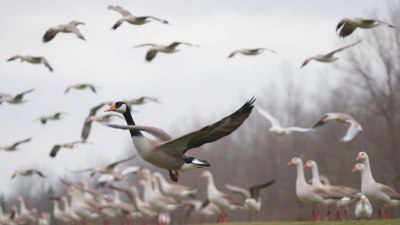Why the Local Geese Are Probably Plotting Based on the Wind
Explore how local geese use wind patterns to strategize movements and behavior in their habitats.

Image created with Flux Schnell
Geese have long captured human curiosity with their complex social behaviors and migratory patterns. Among the many fascinating aspects of their behavior is the way they seem to coordinate and adapt to their environment, particularly the wind. While it might be tempting to anthropomorphize and suggest that local geese are "plotting" based on the wind, there is strong ecological and biological reasoning behind their wind-related actions and strategies. This article delves deep into how geese likely use wind patterns to influence their behavior, movement, and survival tactics, drawing from ornithological research and ecological principles.
Understanding Geese Behavior and Social Structure
Geese are known for their highly social lifestyles, often living in tight-knit groups or flocks. The social structure of geese plays a crucial role in their survival, allowing them to communicate warning signals, share knowledge of feeding grounds, and coordinate migratory movements. This social cohesion suggests a level of group strategy, which, when combined with environmental cues like wind, leads to their seemingly intelligent and adaptive behaviors.
In the wild, geese rely on interplay within their flock and environmental awareness to make decisions. Wind conditions provide important contextual information—affecting flight efficiency, predator avoidance, and thermoregulation. Research indicates that geese likely assess wind speed and direction to optimize their flight paths during local movements and long-distance migration.
The Role of Wind in Flight Dynamics
Flight is energy-intensive. For migratory species like geese, reducing the energy cost is essential for survival, particularly during long journeys spanning thousands of kilometers. Wind plays a major role in this calculation. Tailwinds help birds conserve energy by boosting their airspeed, allowing them to cover large distances with less effort. Conversely, headwinds require more power to maintain speed and could increase the risk of exhaustion or the need to stop frequently.
Geese have been observed timing their takeoffs with favorable wind conditions. When local geese prepare for flight within their habitats—whether to forage, avoid predators, or regroup—they often launch into the wind to maximize lift. This takeoff strategy is a deliberate adaptation, as flying against the wind during takeoff reduces the ground speed needed to generate lift, enabling quicker and safer departures.
Reading Wind as a Navigation Tool
Besides energy optimization, wind serves as a form of navigational input. Geese can detect subtle changes in wind velocity and direction, which aids in their sense of spatial orientation. This ability helps them maintain course during migration and navigate within their local territories more effectively. Recent studies suggest that geese can integrate wind information with visual and magnetic cues to enhance their navigation accuracy.
Because wind flows may change during the day due to thermal currents or weather shifts, geese appear capable of reassessing their movement strategies repeatedly. Local geese exercising these recalibrations seem to "plot" or strategize routes that balance energy use, predator avoidance, and foraging opportunities.
Wind and Predator Evasion
Predator evasion is another crucial reason geese attend closely to wind conditions. Sound travels differently depending on wind direction; approaching predators might be masked by the wind or betrayed by its direction. By taking off or landing with the wind, geese can better control noise and visual cues, making it harder for predators to detect them. For example, geese might position themselves downwind of potential threats, ensuring their senses pick up on danger before the predator gets too close.
This strategic positioning based on wind demonstrates a sophisticated survival instinct. Instead of random behavior, local geese show patterns consistent with learned and evolved responses to environmental variables.
Thermoregulation and Comfort
The physical comfort of geese also relates to wind patterns. On hot days, wind helps dissipate body heat, allowing geese to thermoregulate efficiently. On cold days, they might seek sheltered areas downwind to minimize heat loss. These movements and group formations based on wind conditions further reinforce the idea that local geese adjust their actions with precise environmental awareness rather than whim.
Group roosts can shift positions depending on the direction and strength of the wind, maximizing collective comfort and minimizing exposure to elements. This behavior often looks like coordinated action, underpinning the impression that the geese are following a planned strategy tuned to the wind.
Communication and Wind
Geese make a wide range of vocalizations that serve as calls for alarms, coordination, or mating. Wind affects how these sounds travel, influencing when and how geese choose to communicate. For example, they may call louder or change call timing based on wind direction to ensure their messages reach intended receivers effectively. This adaptability highlights how geese factor wind into their social coordination, further supporting the hypothesis that their behavior is plotted rather than random.
Moreover, changes in wind can affect the flock’s movement patterns as vocal communication informs flight formations, such as the iconic V-formation. This aerodynamic configuration benefits from the wind by reducing drag for trailing geese, and shifts in wind conditions require immediate coordination communicated vocally.
Scientific Evidence Supporting Wind-Based Behavior
Multiple scientific studies corroborate the importance of wind in bird behavior. Radar tracking of migratory birds has revealed that geese and other species adjust their altitude and speed based on wind conditions. Biomechanical analyses demonstrate that birds select flight paths that optimize energetic efficiency relative to wind vectors. Field observations confirm geese preferentially take off into the wind and land facing it.
Ecologists have also studied local populations and found correlations between wind patterns and daily movement schedules. These studies underscore a biological basis for the apparent "plotting" and demonstrate that what might look like intricate planning is grounded firmly in natural selection and adaptive evolution.
Implications for Wildlife Management and Conservation
Understanding the relationship between local geese behavior and wind is not just academic curiosity; it has practical implications. Conservation efforts can benefit by recognizing critical habitats that offer optimal wind conditions for feeding, resting, and escape from predators. Managing windbreaks and natural features can improve geese welfare and survival odds.
Moreover, in urban and suburban settings where geese live near humans, insights into wind-based behavior can guide habitat design, minimizing conflicts and supporting sustainable coexistence. For instance, knowing typical takeoff directions relative to prevailing winds can help locate safe flight corridors, reducing risks of bird strikes or disturbances.
Advanced Technologies in Studying Wind-Behavior Interaction
Modern technology allows unprecedented study of how geese interact with wind. GPS tracking, drones, and wind modeling combined with behavioral observation enable researchers to dissect the links between atmospheric conditions and goose movements. These tools reveal micro-strategies geese employ, such as timing local flights to optimal wind windows and adjusting flock formations dynamically.
Such research contributes to broader understanding of avian ecology, highlighting how wind and weather shape daily decisions and long-term survival strategies of local geese. The integration of ecological data and computational models is paving the way for more detailed predictions about goose behavior under changing climate scenarios.
Myths and Misconceptions about Goose Intelligence and "Plotting"
It is easy to anthropomorphize wildlife behavior, projecting human intentions onto animal actions. When local geese seem to "plot" with the wind, it’s tempting to imagine secret meetings or conspiracies. However, these behaviors largely arise from instinctive and learned responses to environmental cues finely tuned by evolution.
While geese do display remarkable intelligence, including memory for migration routes and social recognition, the use of wind is more a natural response than a conscious plan. Understanding this distinction helps deepen appreciation for wildlife complexity without distorting scientific truth.
The Wind as a Meta-Environmental Factor
Wind acts as a meta-environmental factor influencing many ecological processes beyond just goose behavior. It facilitates seed dispersal, shapes landscape formation, and drives climatic patterns that indirectly affect geese habitats. Local geese's reliance on wind patterns exemplifies how animal behavior is intricately connected to broader environmental systems.
This interconnectedness suggests that protecting air quality and natural wind corridors in ecosystems is crucial for maintaining balanced wildlife communities. By appreciating the role wind plays in enabling geese to effectively manage their daily routines, we recognize the broader importance of preserving natural atmospheric processes.
Future Directions in Research and Observation
Ongoing research into goose behavior will likely uncover more nuanced ways wind interacts with animal ecology. Advances in sensor technology may document physiological changes in geese triggered by wind shifts, such as heart rate or muscle activity during flight. Similarly, long-term climate studies might predict how changing wind patterns could alter migration timing and habitat use.
Citizen science projects involving bird watchers could improve data on local goose movements relative to daily wind changes. Such grassroots efforts combined with academic research can produce comprehensive insights, enriching our understanding of how these animals thrive in constantly changing environments.
In sum, local geese do not literally plot conspiracies, but their behavior shows remarkable adaptation to wind conditions. This allows them to optimize energy, enhance survival, and maintain social coordination. The wind acts as an invisible guide and natural cue, shaping their movements and interactions in ways humans are only beginning to fully grasp.











